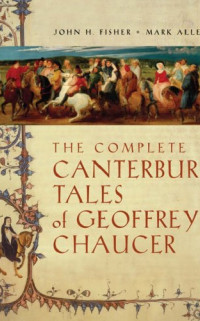Primary data
Title: The Canterbury Tales
Author: Geoffrey Chaucer
Originally published: 1400
Editor: Arthur Burrell
Description
I decided to read The Canterbury Tales because it’s a famous piece of literature. I’ve always been very interested in history and especially in the Middle Ages. The Canterbury Tales is a mediaeval framework which describes a pilgrimage to the shrine of St. Thomas Becket at Canterbury Cathedral. Thirty pilgrims tell each other stories to kill time. The person that tells the best story gets rewarded with a free meal. The innkeeper chooses the winner. The first story is being told by a knight.
line 855 He seyde, "Syn I shal bigynne the game,
What, welcome be the cut, a Goddes name!
Now lat us ryde, and herkneth what I seye."
And with that word we ryden forth oure weye,
And he bigan with right a myrie cheere.
The book contains only 24 stories, experts believe that this is because the author wasn’t able to complete his work. The author died in 1400.
Deepening
Theme: people of society seeking a greater good.
Motifs: Christianity, journey, relationships, morality, and penance.
Time: The Canterbury Tales were set in the 14th century.
Style
There is no particular genre. The genre and style differs. Some stories are written with wit and irony, other stories are of serious nature.
Setting
The setting doesn’t play a significant role in the work. The pilgrimage starts at the Tabbard Inn in Southwark, East-London and ends in Canterbury.
Perspective
I-narrator: the narrator takes part in the story as one of characters, subjective perspective. The story is described the way the narrator sees it. The stories are told by different narrators.
Language
In the 13th century most of the literature was written in French or Latin. Poetics were only written in those two upper-class languages. The Canterbury Tales were written in English, the language of the lower class. For the first time in history poor and uneducated people were able to read poetry, this created a revolution in literature. Middle English sounds quite like the modern English when pronounced.
Characters
The characters differ in personal characteristics (unreliable, adulterous, alcoholic) and social status (parson, knight, miller). This creates an accurate outline of mediaeval life.
Poetry
line 165 General Prologue - The monk
A MONK ther was, a fair for the maistrie,
An outridere, that lovede venerie,
A manly man, to been an abbot able.
Ful many a deyntee hors hadde he in stable,
And whan he rood, men myghte his brydel heere
Gynglen in a whistlynge wynd als cleere.
Rhythm
The above chanted:
v-v-v-v-v-
v-v-v-v-v-
v-v-v-v-v--
v-v-v-v-v-v--
v-v-v-v-v-
-v-vv--v-
v = unstressed syllable
- = stressed syllable
In the first two sentences are five iambs which means that the first two sentences are iambic pentameters. The third and fourth sentence also contain iambs but they end with a spondee (a foot consisting of two stressed syllables). The author used the spondees to create sudden strong emphasises. The fifth sentence is an iambic pentameter. The last sentence starts with two trochees, followed by a dactyl and ends with an iamb.
Rhyme
The example above is written in perfect rhyme because the final stressed vowels and following sounds are identical.
Masculine (the stress is on the final syllable of the words): maistrie-venerie, heere- cleere.
Feminine (the stress is on the penultimate syllable of the words): able-stable.
Oblique (rhyme with an imperfect match in sound): fair-outridere.
Semirhyme (rhyme with an extra syllable on one word): manly man.
Assonance (matching vowels): myghte-brydel- gynglen-whistlynge wynd, an abbot able.
Alliteration (matching initial consonants): fair for, hors hadde he, whistlynge wind.
Sources
The Canterbury Tales. http://www.bibliomania.com/0/2/14/24/frameset.html
Prosody. Prof. Engbers. http://web.archive.org/web/20050212131935/www.calvin.edu/
Evaluation
It’s a dated work, the language that has been used isn’t similar to the modern English. This makes it sometimes hard to understand what the author is telling. The rhyme however is magnificent. I wouldn’t recommend this book to others because it’s difficult to read.
The Canterbury tales door Geoffrey Chaucer


ADVERTENTIE
Overweeg jij om Politicologie te gaan studeren? Meld je nu aan vóór 1 mei!

Misschien is de studie Politicologie wel wat voor jou! Tijdens deze bachelor ga je aan de slag met grote en kleine vraagstukken en bestudeer je politieke machtsverhoudingen. Wil jij erachter komen of deze studie bij je past? Stel al je vragen aan student Wouter.
Meer informatie








REACTIES
:name
:name
:comment
1 seconde geleden